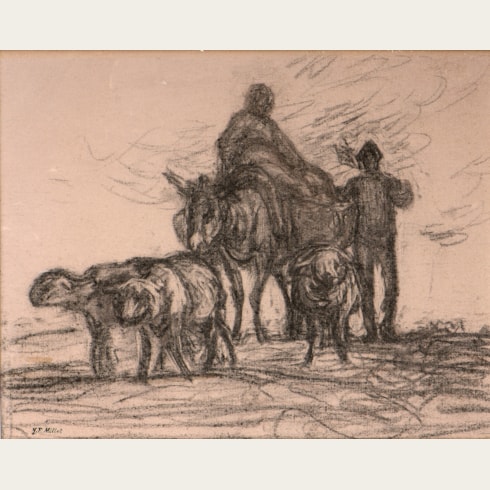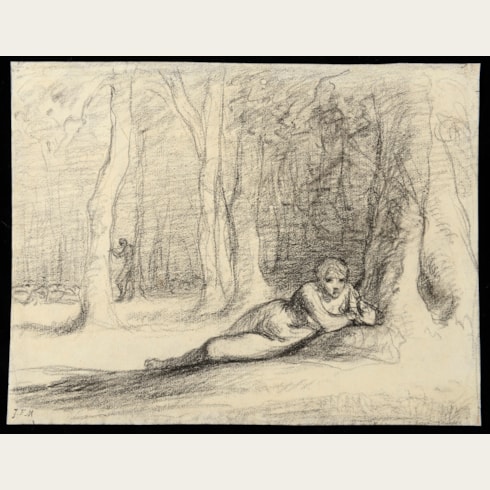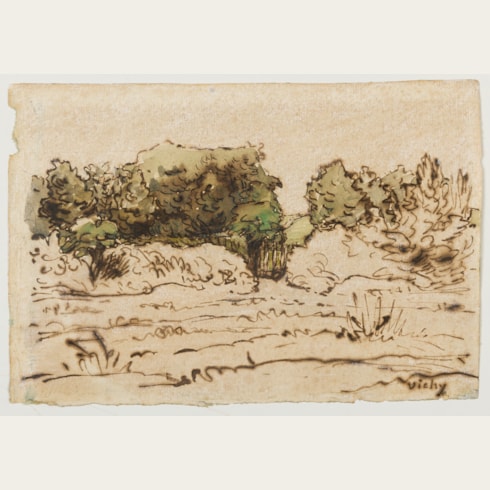Jean-François MILLET
(Gruchy 1814 - Barbizon 1875)
A Peasant at Work in a Field
Sold
Charcoal, with stumping, on buff paper. Laid down.
353 x 307 mm. (13 7/8 x 12 1/8 in.)
353 x 307 mm. (13 7/8 x 12 1/8 in.)
Many of Millet’s finest drawings are studies of peasant men and women at work. This was a world he knew well, and one that he was born into. As a young boy in the small village of Gruchy in Normandy, Millet had worked alongside his father on his family’s farm - looking after the animals, tilling the soil, sowing and reaping – and remained proud of these experiences throughout his later life as an artist. Millet remained deeply attached to the idea of the French countryside, and to the people who lived and worked there, and strove to accurately and sympathetically represent their daily lives in the paintings he sent to the annual Salons. As Robert Herbert has written, ‘[Millet’s] view of the peasant was a conservative one. He was convinced that man is condemned forever to bear his burdens, hence he made the peasant into a victim of unyielding fate that kept him in the unchanging cycle of work and exhausted repose, the cycle that has been his lot since ancient times.’ But at the same time Millet’s peasant figures are often imbued with a sense of dignity, and at times even of grandeur. Indeed, as Herbert points out, ‘His work joined in a complex process that resulted in the elevation of common man to the rank of history painting.’
Previously unknown and unpublished, this powerful sheet is unusually large among Millet’s charcoal drawings, and has the appearance of a finished work for sale, or perhaps to be given away as a present. However, the lack of a signature would suggest that it was part of a repertory of figure poses that the artist chose to keep in his studio. Millet often produced drawings that served to celebrate any and all manner of farm work, even such prosaic activities as the spreading of manure depicted in the present sheet.
A related chalk drawing, smaller in scale and horizontal in format, showing the same figure in an extensive landscape with a waggon in the distance, is in the collection of the Mohamed Mahmoud Khalil Museum in Cairo, Egypt. As Alexandra Murphy has noted of the Cairo drawing, ‘Millet understood the twisting, tiring movements involved in spreading manure’, and this is even more evident in this large and impressive sheet, which focuses on the vigorous actions of the man. The Cairo drawing is part of a coherent group of around twenty drawings of farm workers, executed in Barbizon in the early 1850’s and known collectively as the L’Epopée des champs (Epic of the fields), which the artist kept for himself and which served as inspiration for the remainder of his career. The present sheet may be similarly dated to between 1849 and 1852, with the broad plain of Barbizon visible in the background of both drawings.
Previously unknown and unpublished, this powerful sheet is unusually large among Millet’s charcoal drawings, and has the appearance of a finished work for sale, or perhaps to be given away as a present. However, the lack of a signature would suggest that it was part of a repertory of figure poses that the artist chose to keep in his studio. Millet often produced drawings that served to celebrate any and all manner of farm work, even such prosaic activities as the spreading of manure depicted in the present sheet.
A related chalk drawing, smaller in scale and horizontal in format, showing the same figure in an extensive landscape with a waggon in the distance, is in the collection of the Mohamed Mahmoud Khalil Museum in Cairo, Egypt. As Alexandra Murphy has noted of the Cairo drawing, ‘Millet understood the twisting, tiring movements involved in spreading manure’, and this is even more evident in this large and impressive sheet, which focuses on the vigorous actions of the man. The Cairo drawing is part of a coherent group of around twenty drawings of farm workers, executed in Barbizon in the early 1850’s and known collectively as the L’Epopée des champs (Epic of the fields), which the artist kept for himself and which served as inspiration for the remainder of his career. The present sheet may be similarly dated to between 1849 and 1852, with the broad plain of Barbizon visible in the background of both drawings.
One of the founders of the Barbizon school of painting in France, Jean-François Millet studied at the Ecole des Beaux-Arts in Paris. It was in Paris in the 1840’s that Millet became associated with a group of landscape painters who were to become part of the Barbizon circle, including Théodore Rousseau, Constant Troyon, Narcisse Diaz de la Peña and Charles Jacque. Although Millet’s early career was dominated by portraits, by the 1850’s he began to paint pastoral subjects, many of which were acquired by his first patron and future biographer Alfred Sensier. Millet established his public reputation as a painter of peasant life with three seminal paintings; The Sower, exhibited in 1850, The Gleaners, painted in 1857, and The Angelus, completed in 1859. By the 1860’s Millet enjoyed a very successful career, receiving many commissions for paintings and, from the Parisian architect and collector Emile Gavet, for a series of highly finished pastel drawings. Honoured with an exhibition of his work at the Exposition Universelle in 1867, Millet was elected to the jury of the Salon in 1870, but by this time was already beginning to suffer from poor health. Four months after the artist’s death in January 1875, the contents of his studio were dispersed at auction.
Millet was a skilled draughtsman, whose work ranged from quick sketches and more elaborate figure studies, to landscape studies in pen and watercolour, to highly finished pastel drawings that were sold as autonomous works of art, often for considerable sums of money. Robert Herbert has noted that ‘Millet’s penchant for drawing was catered to by the nature of his market. In the early years at Barbizon he sold few paintings at all, and at such derisory prices that the sale of three or four drawings could produce the same income…As the decade progressed – especially after the relative success of his Salon of 1853 – Millet acquired more opportunities for selling oils. Drawings still held priority, however, for they were his instinctive way of creating. Almost all his paintings were chosen from among drawings that had already been completed.’1 In the last decade of his career, landscape began to assume a more important role in his art, inspired in part by his travels beyond Barbizon. Although Millet lived in Barbizon from 1849 till the end of his career, he often spent summers elsewhere, such as his native Normandy and the Auvergne.
Provenance
Pierre Berès, Paris.







